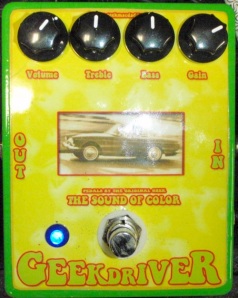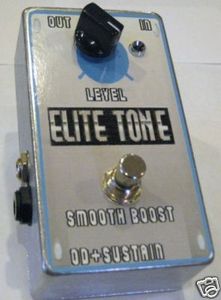Possible Answers:
- 5 Years Ago – 10 Years Ago: I’m obsessed and have no self-control.
It wasn’t a pretty sight during that time. I was spending pretty much everything on gear in my lust for finding the right tone. This coincided with my move from solid-state to tube amps. - 3 Years Ago: I’ve purchased all this gear, and I’m a pack-rat and don’t want to get rid of it.
Yeah, I sold off a couple of things, but for the most part kept pretty much everything I purchased. - 1 Year Ago: Same as 3 years ago, but I’ve refined my use of different gear to different venues/situations. Instead of buying more gear to satisfy a sound that I’m hearing in my head, I look at the gear I have and see if I can get it. More often than not, I’ve found that I have gear that will meet my particular needs.
Answer 3 is how I now answer the wife… 🙂
But seriously, after buying all that gear, what I found is that some gear just works better with some rigs or venues than others – even set lists. For instance, I’m glad I have duplicates of several of my modulation pedals because some work better in a live situation, while others work better in the studio. Furthermore, some work much better with my acoustic rig, while others work better with my electric rig. As a result, I have three pedal boards. One is dedicated to acoustic and two I use for my electric rig.
On my acoustic board, I use an MXR Carbon Copy Delay, Homebrew THC Chorus and a TC Electronic Hall of Fame Reverb for modulation pedals. I also have a simple BOSS LoopStation RC-2 looper along with a TC Helicon VoiceLive Play GTX vocal processor.
For my electric rig, what board I use is really dependent upon how I’m feeling that day, and the amp that I’m playing. I have 10- and a 4-pedal boards. I normally only use my 4 pedal board which will include a tuner, an overdrive, a chorus, and a reverb for pretty much any amp. Occasionally, I’ll swap the reverb or chorus out for a delay pedal, or switch the overdrive out for a distortion pedal.
But occasionally I need a lot of versatility, so I’ll break out the “big” board and load it up as follows:
Lower Level – These go straight into the amp
- BOSS TU-2 Tuner (I’ve had this forever and it still serves me well)
- Timmy Overdrive for transparent OD
- Another overdrive that will work the guitar/amp I’m playing that day (Could be a Tube Screamer-like, or whatever I might be in the mood for color-wise)
- EWS Little Brute Drive (I might even have yet one more overdrive here that will be used for stacking with the Timmy)
- VOX Big Bad Wah
Upper Level – These go into my effects loop (and all these work with any amp or guitar I have)
- TC Electronic Corona Chorus
- Mad Professor Deep Blue Delay
- Hardwire Reverb
- Creation Audio Labs Mk.4.23 Booster
Some might be wondering why I put a booster in the last position. I actually learned this from Mean Gene Baker. It doesn’t necessarily add much volume, but it does ensure that my power tubes get saturated.
As for guitars, I have a bunch, but really only play five of them regularly at this point. I have my trusty Yamaha APX900 acoustic, then for electrics, I use my ’58 Re-issue, ’59 Replica Les Pauls, my custom Slash L Guitars “Katie May,” and an American Deluxe Strat. I’ll occasionally take out my others, but they’re kind of in a dormant state right now…
The cool thing about having so much gear is that I have options. I’ve acquired enough that as I mentioned above, I can almost always find what I need with what I have. The net result is that even though I still dig new gear, I’m now less compelled to go out and even try it because I’ve got all I need right now. Of course, that will probably change as I explore other genres of music. But for now, I’m going to be digging into my “grab bag.”







 If I’ve said it once, I’ll say it again. The market cannot have too many overdrive pedals. 🙂 As you know if you read this blog with regularity, I just love ’em. I know… there’s nothing like the sound of a cranked amp, yada-yada-yada… But to get to the type of amp drive that I like; that is, with both pre-amp and power tubes contributing to the distorted sound, the volume levels will make your ears bleed. Enter the overdrive pedal, which gives you that breakup tone at any volume level! And the reason I love OD pedals so much is because I personally haven’t come across any two from different makers that sound exactly alike. Sure, many cop the tone of some original design – can you say Tube Screamer – but even the “clones” have voices all their own as their manufacturers add features or make the original circuits more efficient.
If I’ve said it once, I’ll say it again. The market cannot have too many overdrive pedals. 🙂 As you know if you read this blog with regularity, I just love ’em. I know… there’s nothing like the sound of a cranked amp, yada-yada-yada… But to get to the type of amp drive that I like; that is, with both pre-amp and power tubes contributing to the distorted sound, the volume levels will make your ears bleed. Enter the overdrive pedal, which gives you that breakup tone at any volume level! And the reason I love OD pedals so much is because I personally haven’t come across any two from different makers that sound exactly alike. Sure, many cop the tone of some original design – can you say Tube Screamer – but even the “clones” have voices all their own as their manufacturers add features or make the original circuits more efficient.